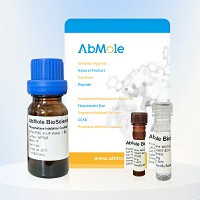All AbMole products are for research use only, cannot be used for human consumption.

Recombinant Human VEGF165 Protein (HEK293, C-His) is a powerful growth and angiogenic cytokine. It promotes the proliferation and survival of endothelial cells, promotes angiogenesis and vascular permeability. VEGF is expressed in vascularized tissues and plays an important role in normal and pathological angiogenesis.
Measured by human umbilical vein endothelial cells (HUVEC) proliferation assay, the ED50 for this effect is ≤20 ng/mL.
DNA sequence encoding human VEGF165 (NP_001165097.1) is expressed with a His tag at the C terminus.
The recombinant human VEGF165 protein contains 193 amino acids and has a predicted theoretical molecular weight of 22.3 kD.
Endotoxin <0.1EU/μg

Cell Death Dis. 2023 Mar 11;14(3):194.
USP22 upregulates ZEB1-mediated VEGFA transcription in hepatocellular carcinoma
Recombinant Human VEGF165 Protein (HEK293, C-His) purchased from AbMole

Patent. US2023364025A1 2023 Nov 16.
Patent. US2023364025A1
Recombinant Human VEGF165 Protein (HEK293, C-His) purchased from AbMole

Sci Rep. 2019 Nov 28;9(1):17745.
In vivo delivery of VEGF RNA and protein to increase osteogenesis and intraosseous angiogenesis
Recombinant Human VEGF165 Protein (HEK293, C-His) purchased from AbMole
| Solubility (25°C) | Reconstitute the lyophilized powder in ddH2O or PBS up to 100 μg/ml. |
| Storage | Stored at ≤ -20°C, stable for one year after receipt. Reconstituted protein solution can be stored at 2-8°C for 2-7 days and at -20°C for 3 months. |
| Related Cytokines and Growth Factors Products |
|---|
| Recombinant Human GDF-15 Protein (HEK293 N-hFc)
Growth-differentiation factor 15 (GDF15), also known as MIC-1, is a secreted member of the transforming growth factor (TGF)-β superfamily. GDF-15 has a role in regulating inflammatory and apoptotic pathways in injured tissues and during disease processes. GDF-15 overexpression arising from an expanded erythroid compartment contributes to iron overload in thalassemia syndromes by inhibiting hepcidin expression. |
| Recombinant Human FGFR1 Protein (HEK293, C-His)
FGFR1, also known as CD331, is a full-length representative protein consists of an extracellular region, composed of three immunoglobulin-like domains, a single hydrophobic membrane-spanning segment and a cytoplasmic tyrosine kinase domain. |
| Recombinant Human FGFR2 Protein (HEK293, C-His)
FGFR2, also known as CD332, acts as cell-surface receptor for fibroblast growth factors and plays an essential role in the regulation of cell proliferation, differentiation, migration and apoptosis, and in the regulation of embryonic development. FGFR2 plays an essential role in the regulation of osteoblast differentiation, proliferation and apoptosis, and is required for normal skeleton development. It also promotes cell proliferation in keratinocytes and imature osteoblasts, but promotes apoptosis in differentiated osteoblasts. |
| Recombinant Mouse BMP-4 Protein (E. coli, C-His)
Bone Morphogenetic Protein-4 (BMP-4) is a critical signaling molecule required for the early differentiation of the embryo and establishing of a dorsal-ventral axis. BMP-4 is secreted from the dorsal portion of the notochord, and it acts in concert with sonic hedgehog to establish a dorsal-ventral axis for the differentiation of later structures. |
| Recombinant Human Coagulation Factor X (HEK293, C-Fc)
Coagulation factor X, belongs to the peptidase S1 family. Coagulation factor X is initially synthesized in the liver. Coagulation factor X is a vitamin K-dependent glycoprotein that converts prothrombin to thrombin in the presence of factor Va, calcium and phospholipid during blood clotting. |
All AbMole products are for research use only, cannot be used for human consumption or veterinary use. We do not provide products or services to individuals. Please comply with the intended use and do not use AbMole products for any other purpose.


Products are for research use only. Not for human use. We do not sell to patients.
© Copyright 2010-2024 AbMole BioScience. All Rights Reserved.
